For some states, the last day to register to vote is less than a month away—while 21 states and D.C. allow voters to register and vote on Election Day.

We have seven weeks until Election Day, but voters in most states—except those in Mississippi, Alabama and New Hampshire—will have the opportunity to vote in mere weeks. In 2022, less than half (43 percent) of voters actually voted on Election Day; 36 percent voted by mail and 21 percent voted in person before Election Day. This means that the majority of votes for the November elections will be cast next month, in October.
For some states, the last day to register to vote is less than a month away. Currently, 21 states and D.C. allow voters to register and vote on Election Day, and during early in-person voting.
With just under two months left until the November elections, now is the time for voters to stay on top of their registration, especially as restrictive voting laws have been on the rise within the last year. In 2023, 14 states enacted restrictive voting laws, all of which will be in place for the upcoming elections, according to the Brennan Center. Many of these laws specifically target mail-in voting by shortening the window to request a ballot or banning drop boxes:
- A new Texas law allows voting locations to be consolidated, which will likely place voters farther from their closest polling location and create longer lines at those locations.
- In North Carolina, new laws end the three-day grace period for receiving absentee ballots as long as they are postmarked by Election Day, ban drop boxes and decrease the governor’s oversight over the election.
States with the earliest voter registration deadlines require voters to register in less than a month:
- Alaska and Rhode Island both have a voter registration deadline of Oct. 6, but both provide same-day registration and voting in the presidential election.
- South Carolina has an in-person registration deadline of Oct. 4—the online deadline is Oct. 6, followed by a postmarked mail deadline on Oct. 7.
- Arizona, Arkansas, Florida, Georgia, Indiana, Kentucky, Louisiana, Mississippi, Montana, Ohio, Tennessee and Texas all have voter registration deadlines of Oct. 7. Louisiana also has an online deadline of Oct. 15 and Montana allows in-person registration and voting on Nov. 5.
At the same time, 23 states moved to expand voting rights and access in the last year:
- New York is encouraging early registration by requiring high schools to distribute voter registration forms to students.
- A law in Michigan has increased its window for early voting and made it easier to vote by mail.
- Colorado has passed a law expanding its automatic voter registration program to Native American reservations.
I’m in College. Where Can I Vote?
Students have a constitutional right to register and vote where they are attending college. In battleground states, it’s particularly important that they register and vote in that state’s elections for president, U.S. Senate and House races.

Republican politicians in some states have passed laws to try to suppress students’ votes—for example, by requiring in-state vehicle registration. But that should not stop students from registering and voting. To register to vote, they should use the National Mail Voter Registration Form, which allows out-of-state students to register to vote in federal races in the state where they are going to college (president, vice president, U.S. Senate, U.S. House of Representatives) using the last four digits of their Social Security number. This is particularly important for students attending college in the battleground states of Arizona, Nevada, Wisconsin, Michigan, Pennsylvania, North Carolina, Georgia, and in races for the Senate in Ohio and Montana.
- You must follow the state-specific instructions listed for your state. They begin on page 3 of the form and are listed alphabetically by state.
- After filling out this form, you must print it out, sign your name where indicated and send it to your state or local election office for processing (address provided in the state specific instructions).
- Be sure you mail it in an envelope with the proper amount of postage first class (73 cents).
Students attending college in a state are “residents” of that state for voting purposes. Even if they originally lived or their parents currently live in another state, they can register and vote in the state where they are going to college. Registering to vote in the state where they are going to college will have no effect on their student loans or financial arrangements, or their parents’ taxes.
College students can be the margin of difference in a close election.
- In the 2020 presidential election, Wisconsin was decided by only 21,000 votes out of 3.25 million votes cast.
- The Presidential election in Arizona in 2020 was decided by only 10,457 votes, out of 3.3 million votes cast.
- The Senate race in Nevada in 2022 was decided by just 7,928 votes, out of 1.37 million votes cast.
Am I Eligible to Vote?
In order to be eligible to vote you must:
- be a citizen of the United States.
- be at least 18 years of age on Election Day.
- have been a resident of the state you plan to vote in for at least 30 days.
How Do I Know if I Am Registered?
If you are unsure of your voter registration status, verify yours here.
At What Age Can I Register to Vote?
Although citizens in the U.S. can’t vote until age 18, in many states people can pre-register to vote as early as 16 years old. You can find out what your state’s pre-registration requirements are here.
At Ms. magazine, our mission is to deliver facts about the feminist movement (and those who stand in its way) and foster informed discussions—not to tell you who to vote for or what to think. We believe in empowering our readers to form their own opinions based on reliable reporting. To continue providing you with independent feminist journalism, we rely on the generous support of our readers. Please consider making a tax-deductible donation today if you value the work we do and want to see it continue. Thank you for supporting women’s voices and rights.





